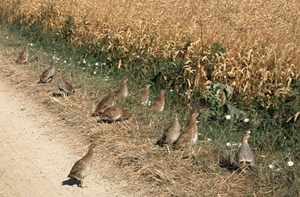By Alex Keeble, Game and Wildlife Advisor (Central England)
 Often many shoots attempt to re-establish grey partridges through releasing. However, re-establishment efforts are prolonged, labour-intensive and expensive operations with no guarantee of success.
Often many shoots attempt to re-establish grey partridges through releasing. However, re-establishment efforts are prolonged, labour-intensive and expensive operations with no guarantee of success.
From our extensive research of the grey partridge we suggest that where grey partridges are still present (over two pairs/km² on at least 4km² or 400 hectares), releasing is unsuitable. This is mainly due to the fact that we know from our research that if wild birds are already present then it is possible to increase the numbers via habitat management, predation control and supplementary feeding. (Our project at Royston, Hertfordshire increased pairs in five years from 2.9 pairs/km² to 18 pairs/km²). If the numbers fail to increase then one of these key elements is lacking, or the weather has had a significant effect on nesting success during that year.
The three key measures that need to be in place before re-establishment are:
- Habitat – Provide the correct type and amount of habitat. This includes over-winter and spring cover, nesting, foraging cover and brood rearing. A mixed mosaic of habitat across the land parcel will aid the success of the re-establishment process. Habitats need to be in close proximity to one another so the birds can easily access the brood rearing cover after hatching. Consider sowing the GWCT Partridge mix available at Oakbank, Bright seeds or Kings Game and Conservation Cover Crops.
- Predation control – Manage key predators of grey partridges (foxes, stoats, weasels, rats, crows and magpies) with a focused predation management plan during February-June. This will involve running extensive tunnel trapping lines and night shooting.
- Provide supplementary feeding – Utilise hopper feeders across the land holding to maintain a feed supply until the end of May, moving feeders accordingly to reduce rat populations and monitor to control any rat infestations.
The GWCT suggests that if you have under two pairs/km² on at least 4km² or 400 hectares than it may be worth attempting to re-establish a population of grey partridges. However, any release into unfavourable conditions will likely fail, so we suggest that before any releasing occurs, advice is sought to ascertain whether or not the three vital criteria are met. Releasing large numbers of poults that have been artificially reared in brooder sheds will also most likely fail due to the domesticated nature of artificially reared birds and genetically poor breeding stock. Translocated wild birds perform best, however they must be sourced from a viable natural population and caught up during the open season (1 September to 1 February in Great Britain). If translocated birds cannot be sourced, then parent-reared birds would be the next option or bantam reared birds.
Please note that translocating wild grey partridges will require a licence from Natural England.
 Many wild barren grey partridge pairs will often foster captive-reared juveniles, so if you have pairs on the ground already it may be wise to attempt to foster additional birds to these pairs if they fail to raise a brood. Fostering 10-15 juveniles per group, aged 5-8 weeks old, to these pairs is the best method of fostering.
Many wild barren grey partridge pairs will often foster captive-reared juveniles, so if you have pairs on the ground already it may be wise to attempt to foster additional birds to these pairs if they fail to raise a brood. Fostering 10-15 juveniles per group, aged 5-8 weeks old, to these pairs is the best method of fostering.
Do not try to foster reared birds to pairs that already have a wild brood and do not attempt to foster birds older or younger than 5-8 weeks old as they are likely to either lose contact with their foster parents or be rejected by the birds. The juvenile birds can be released within small release pens situated near to a barren pair, and once the pair has been seen near the pen the birds can be released in the hope that the wild pair foster the juvenile birds.
If grey partridges are re-established into an area, monitoring is important to gauge whether the releasing has been successful. Ideally the aim is to record 15% or more of released birds again during the following spring, however if, despite your best efforts, you fail to see more than 15% of released birds again then it may be time to re-assess the releasing programme and seek advice from the GWCT Advisory team at lherring@gwct.org.uk.
The re-establishment process will very often take at least five years to create a newly established population and to maintain or increase numbers on a yearly basis. Understanding the core area of the new population is key and will enable you to focus your attention on this area improving the habitat, increasing supplementary feeding and predation management.
Join the free Partridge Count Scheme, where the spring count measures breeding abundance and the autumn count measures breeding success. Contact Neville Kingdon by email at pcs@gwct.org.uk for more information or go to gwct.org.uk/pcs
For further information, you can read our releasing guidelines.